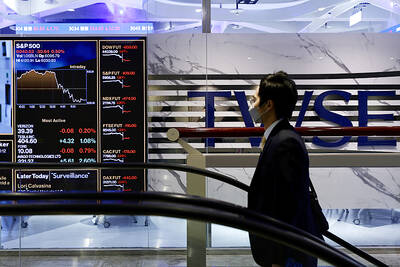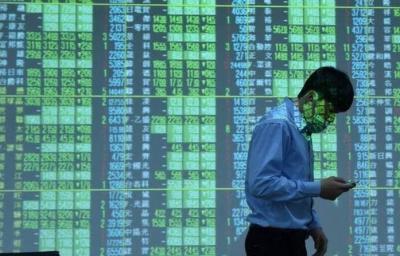The nation’s exports regained traction last month, rising 16.7 percent from a year earlier to a record US$30 billion, driven by strong demand for high-performance chips, cryptocurrency mining and artificial intelligence applications, the Ministry of Finance said yesterday.
Inventory rebuilding among major Chinese smartphone brands also lent support and deepened Taiwan’s trade dependence on the market to a record 44.8 percent, Department of Statistics Director-General Beatrice Tsai (蔡美娜) said.
“The robust showing could sustain this quarter amid continued global economic expansion, while the trade war between the US and China poses the biggest uncertainty,” Tsai told a media briefing.
The two big economies bought 55 percent of shipments from Taiwan, which is home to the world’s largest electronics suppliers, the ministry’s report said.
Electronic parts climbed to US$10.55 billion last month, accounting for 35.2 percent of overall shipments on fast-growing demand for new technology applications and machinery tools used in “smart” production, Tsai said.
Meanwhile, exports of chemical products benefitted from price hikes in raw materials, with a 32.9 percent increase from a year earlier, the report said.
Imports grew 10.4 percent to US$23.4 billion, widening the trade surplus to US$6 billion, a 51.1 percent gain from a year earlier, the it said.
Fourth-quarter exports increased 10.6 percent to US$7.74 billion, beating a projection by the Directorate-General of Budget, Accounting and Statistic by 3.2 percentage points, Tsai said.
Imports picked up 11.3 percent to US$68.4 billion from January to March, allowing trade surpluses to accrue to US$11.6 billion, the report said.
“This warrants an upward revision in exports not only for last quarter, but also for this quarter, as shipments could advance by a double-digit percentage,” Tsai said.
Last year’s high comparison base accounted for the government’s earlier conservative forecast, she said.
All trade partners increased purchases, with China buying a record US$13.43 billion, Tsai said.
Chinese smartphone brands Xiaomi Corp (小米), Oppo Mobile Telecommunications Co (歐珀移動) and Huawei Technologies Co (華為) rebuilt inventory after months of adjustments and are planning new-generation devices, she added.
Imports of capital equipment edged up 1.9 percent to US$3.84 billion last month with purchases by local semiconductor firms staying in negative territory, the report said.
Capital equipment acquisition contracted 0.1 percent for the first three months to US$10.54 billion, it said.
The ministry said that the trade row between the US and China would hurt Taiwan’s exports if it materialized, but added that its effects should be bearable given the details disclosed thus far.
“Some US corporations might shift orders from China to Taiwan if necessary,” Tsai said.

SELL-OFF: Investors expect tariff-driven volatility as the local boarse reopens today, while analysts say government support and solid fundamentals would steady sentiment Local investors are bracing for a sharp market downturn today as the nation’s financial markets resume trading following a two-day closure for national holidays before the weekend, with sentiment rattled by US President Donald Trump’s sweeping tariff announcement. Trump’s unveiling of new “reciprocal tariffs” on Wednesday triggered a sell-off in global markets, with the FTSE Taiwan Index Futures — a benchmark for Taiwanese equities traded in Singapore — tumbling 9.2 percent over the past two sessions. Meanwhile, the American depositary receipts (ADRs) of Taiwan Semiconductor Manufacturing Co (TSMC, 台積電), the most heavily weighted stock on the TAIEX, plunged 13.8 percent in

A wave of stop-loss selling and panic selling hit Taiwan's stock market at its opening today, with the weighted index plunging 2,086 points — a drop of more than 9.7 percent — marking the largest intraday point and percentage loss on record. The index bottomed out at 19,212.02, while futures were locked limit-down, with more than 1,000 stocks hitting their daily drop limit. Three heavyweight stocks — Taiwan Semiconductor Manufacturing Co (TSMC, 台積電), Hon Hai Precision Industry Co (Foxconn, 鴻海精密) and MediaTek (聯發科) — hit their limit-down prices as soon as the market opened, falling to NT$848 (US$25.54), NT$138.5 and NT$1,295 respectively. TSMC's

In a small town in Paraguay, a showdown is brewing between traditional producers of yerba mate, a bitter herbal tea popular across South America, and miners of a shinier treasure: gold. A rush for the precious metal is pitting mate growers and indigenous groups against the expanding operations of small-scale miners who, until recently, were their neighbors, not nemeses. “They [the miners] have destroyed everything... The canals, springs, swamps,” said Vidal Britez, president of the Yerba Mate Producers’ Association of the town of Paso Yobai, about 210km east of capital Asuncion. “You can see the pollution from the dead fish.

TARIFFS: The global ‘panic atmosphere remains strong,’ and foreign investors have continued to sell their holdings since the start of the year, the Ministry of Finance said The government yesterday authorized the activation of its NT$500 billion (US$15.15 billion) National Stabilization Fund (NSF) to prop up the local stock market after two days of sharp falls in reaction to US President Donald Trump’s new import tariffs. The Ministry of Finance said in a statement after the market close that the steering committee of the fund had been given the go-ahead to intervene in the market to bolster Taiwanese shares in a time of crisis. The fund has been authorized to use its assets “to carry out market stabilization tasks as appropriate to maintain the stability of Taiwan’s